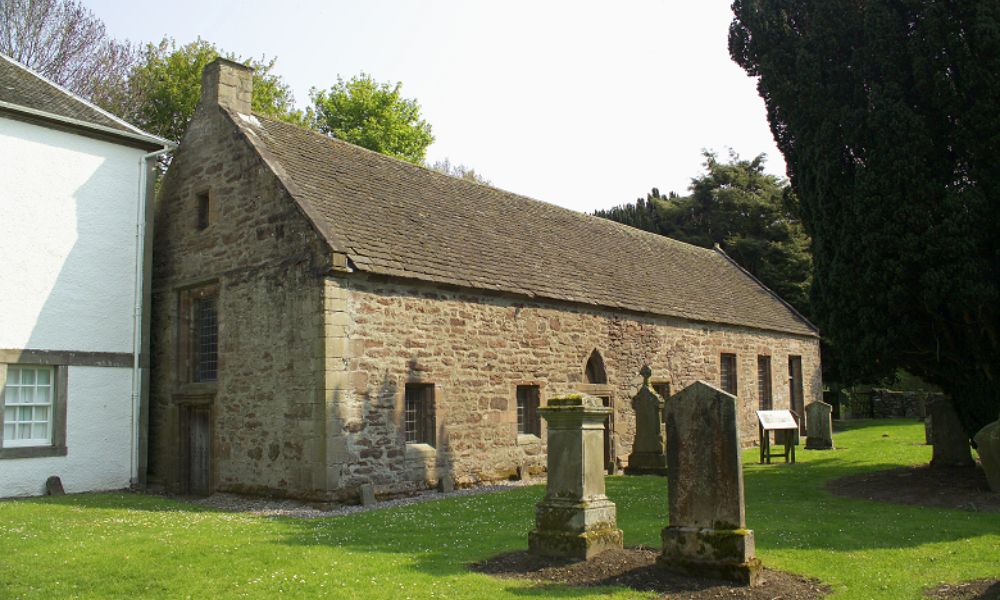Posted by Maris on 25th Mar 2024
Five Stories From Scotland’s Passionate Past
Which romantic episode from Scottish history is your favorite? There is a well-known, tumultuous, and tragic connection between Lord Darnley and Mary Queen of Scots. Perhaps every time you read Burns' A Red, Red Rose, you cry? Did you know that a church in Glasgow is home to one of St. Valentine's relics?
As we explore the passionate past of four Historic Scotland locations, get ready for a virtual Valentine's Day excursion to castles, an abbey, a priory, and a chapel that has been converted into a library. We begin our romantic roundup in the suburbs of Perth.
Jump for my love

It's reasonable to say that a lot has transpired at Huntingtower Castle over the years, including more than its fair share of battles, kidnappings, and conspiracies. The story of the Lover's Leap, however, is one of the more harmless ones.
This story revolves around the peculiar layout of Huntingtower. Although the castle was once made up of two exquisite tower residences spaced roughly three meters apart, it now appears to be a single structure.
the outside of a castle with numerous battlements and turrets. One may picture how the structure was once two independent tower houses next to each other.
It is reported that centuries ago, a visitor to the castle captivated the attention of Dorothea, the daughter of the Earl of Gowrie. She sneaked out of her bed in one of the two structures one night to have a secret tryst in the tower next door.
However, Dorothea's astute mother realized that these tricks were being played and headed to the visitor's room. Dorothea had to go back to her room when she heard her mother's footsteps approaching the staircase. There was just one way out of there.
An illustration of a young woman about to leap or make a jump. The night sky and moon are in the background, and she is dressed in purple.
You guessed it! Anxious Dorothea managed to clear the two towers by leaping about 2.5 meters. Shortly after, her dubious mother discovered her securely nestled in her own bed!
It is said that Dorothea eloped and got married the next day to her boyfriend. The 'Maiden's Leap' or 'Lover's Leap' refers to the space between a battlement and an adjacent tower.

Together forever and never to part

Nestled peacefully atop an island within the Lake of Mentieth lies Inchmahome Priory, which was formerly frequented by notable figures such as Sir Walter Scott, Mary Queen of Scots, and Robert the Bruce. It is also the location of a distinctive effigy that is a strong contender for the title of most romantic object in the extensive Historic Environment Scotland Collections.
In 1258, Walter Stewart, the Earl of Menteith, tied the knot with Countess Mary. Walter adopted his wife's name, as did their offspring, as Mary's claim to the Earldom of Mentieth much surpassed his own inherited claims.
Although the duration of Walter and Mary's marriage is unknown, we might assume that it lasted at least 35 years. It is known that Mary died first, most likely in 1293 or 1294, and that Walter died shortly after.
The pair is depicted sharing a final embrace in the Inchmahome double effigy. Walter is facing his cherished spouse while he lies on his side. It is said that when one puts one arm beneath the other's head, a Gaelic prayer is evoked. We believe that this endearing carving gives us a glimpse of a genuine and tender relationship in history, something we don't often get to see.
Something’s gotten hold of my heart

We're moving on to another romantic effigy next. Just a friendly reminder that there are other examples from Scottish history of people bringing embalmed hearts around, besides James Douglas transporting Robert the Bruce's ticker to Spain!
This 13th-century effigy, located in Sweetheart Abbey, Dumfries and Galloway, is crafted from coarse-grained red sandstone. Despite its severe deterioration and missing head and feet, we are certain that it represents Lady Dervorgilla of Galloway. She is holding a heart-shaped coffin in her hands.
The gravestone-encircled remains of an abbey
Following her husband John Balliol's death in 1268, Lady Dervorgilla carried his heart in a tiny ivory box and carried out numerous charity deeds in his honor. The establishment of the Cistercian monastery of Dulce Cor, which means "sweet heart" in Latin, in 1273 was one of these deeds.
In1279, Lady Dervorgilla passed away. She was still holding her husband's heart to her chest as she was laid to rest in front of the high altar of the abbey church.
An image of an abbey altar featuring white-robed monks going about their everyday activities
I’m just a jealous guy

Of course, happy marriages are hardly a common sight in stories of love. Many macabre stories of unfulfilled love can be discovered throughout Scottish history.
A local tradition of a young man who fell in love with the gardener's daughter at Burleigh Castle may be found in AH Millar's Traditions and Stories of Scottish Castles. After she wed someone else while he was on vacation, the "Lord of Burleigh" was plagued by jealously. He "shot his defenceless rival through the heart" out of wrath.
The outside of a castle with one tower that is mostly destroyed and another that is more complete and has an odd shape
Despite the fact that Millar sets the story in "the unsettled times betwixt the abdication of Queen Mary and the settlement of her son, James VI," it is strikingly similar to the early 1700s adventures of Robert Balfour, 5th Lord Balfour of Burleigh.
It is true that Balfour fell in love with a woman who his family thought was beneath him. He was sent on a Grand Tour overseas as a diversion. He threatened to kill the woman's husband at the first chance if she got married while he was away. Unfazed by these blatant digressions, the woman wed Henry Stenhouse, a Fife schoolteacher, at Inverkeithing.
Balfour arrived back in Scotland in April 1707, straight to the Inverkeithing school. He fired a shot to Stenhouse's shoulder there. After 12 days, the teacher passed away from his injuries. Balfour was put on trial for murder in August. He insisted that his only intention had been to cause Stenhouse pain, noting that Stenhouse continued to survive for nearly two weeks following the incident. Balfour received a death sentence after the defense failed. Still, the riveting story goes on!
By dressing as his sister and fleeing Edinburgh Tolbooth, Balfour managed to avoid being executed. His name did not surface again until 1715, when he loudly proclaimed his sympathy for the Jacobite cause. Rather than the horrible crime of passion, it was his participation in the Jacobite Rising that cost him the family property. He was buried in Edinburgh's Greyfriars Kirkyard after passing away in 1757.
Keep the family close

The small chapel was built about 1507 at Innerpeffray, close to Crieff in Perthshire. Originally, it was constructed as a secret house of worship for the neighboring Innerpeffray Castle. A library was founded in the chapel "for the benefit and encouragement of young students" in the 1600s.
In addition to this literary connection, Innerpeffray has one of Scotland's most amazing gravestones. Mason John Faichney created the Faichney memorial in 1707 upon the passing of his wife. Below a huge picture of the couple is a coat of arms with individual sculptures of their children on either side.
a gravestone with beautiful carvings that features a husband and woman standing arm in arm in the center. A number of further carvings below show the couple's interests and children.
It is the ideal, moving fragment of Scotland's historical landscape for us to appreciate on Valentine's Day. It narrates a story in stone about a man's love for his wife and his pride in his family.

